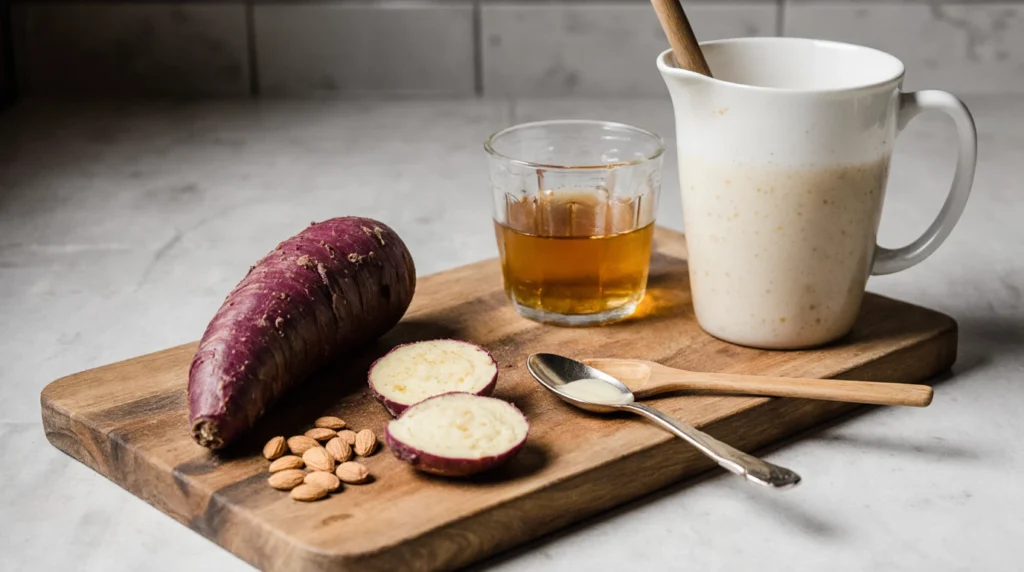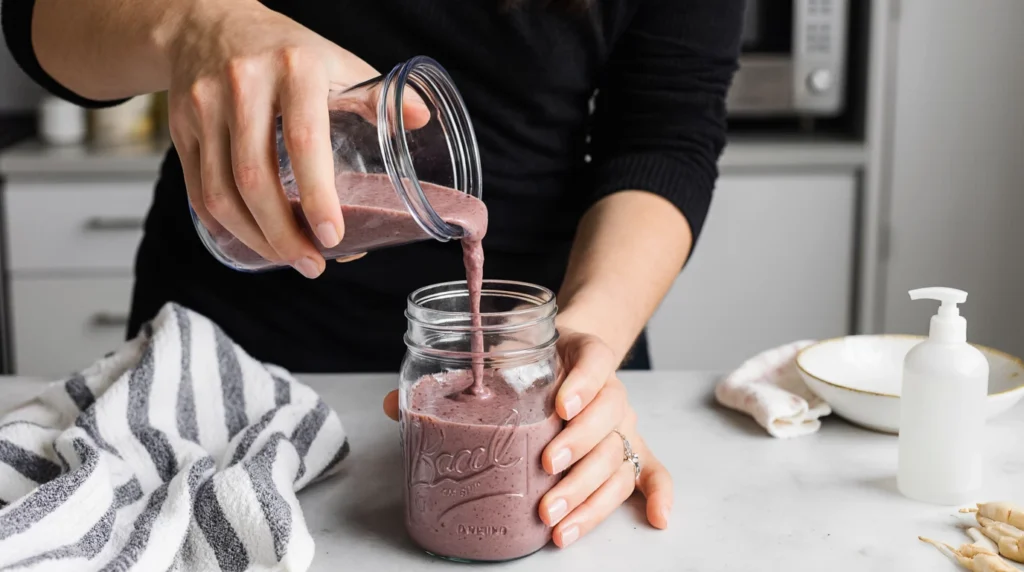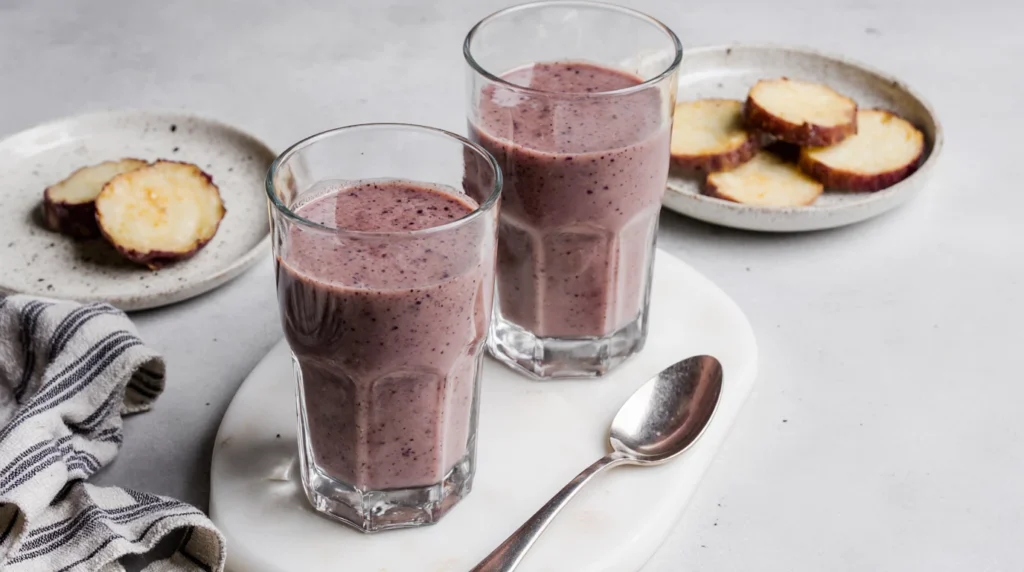Taro root smoothie lovers, this one’s for you
Imagine sipping a creamy, pastel-purple drink that tastes like a perfect mix between vanilla ice cream and mashed sweet potato but healthier. This taro root smoothie uses only three ingredients and five minutes of your time. It looks fantastic, it’s easy to make, and it delivers fiber, vitamins, and natural sweetness, all from the root itself. Ready to blend your day into success? Let’s do this.
What Makes This Taro Root Smoothie So Good
Taro is a tropical root vegetable similar in size to a potato but much sweeter and nuttier in taste. When steamed and blended, it creates a silky, naturally purple base perfect for a smoothie. You can also use taro root powder, but fresh or frozen chunks offer more texture and flavor. This drink is a powerhouse of fiber, resistant starch, and essential nutrients, all while being customizable to suit your taste.

If you’re curious about the difference between using real root and the powdered kind, check out our classic taro smoothie for a sweeter, more bubble-tea-style vibe.
Ingredient Spotlight
1. Cooked or Powdered Taro Root
Choose fresh taro, steam or boil until tender, and pop it into the blender. You can also use good-quality taro root powder instead for convenience. Aim for one cup cooked or two tablespoons powder.
2. Milk of Your Choice
Cow’s milk adds protein; plant-based options like oat, almond, or coconut bring vegan versatility. You decide the thickness by adjusting liquid amount.
3. Natural Sweetener
A teaspoon of honey, maple syrup, or a few dates add a hint of sweetness without making it dessert-level sweet.
Optional Add-ins: chia seeds, protein powders, spices (e.g., cinnamon, nutmeg), matcha, berries, nut butters.
How to Blend This Smoothie
- Prepare your root (cooked or powdered).
- Add 1 cup of taro root to the blender.
- Pour in 1 cup of chosen milk.
- Add sweetener (optional).
- Blend until smooth (about 45 seconds).
- Pour and top with seeds, nuts, or fruit.
Taro Root Smoothie
Macronutrient Table (per serving)
| Nutrient | Amount |
|---|---|
| Calories | 200 kcal |
| Carbohydrates | 35 g |
| – Dietary Fiber | 4 g |
| – Sugars | 10 g |
| Protein | 4 g |
| Fat | 4 g |
| – Saturated Fat | 1 g |
| Potassium | 600 mg |
| Vitamin B6 | 0.3 mg (~15% DV) |
| Vitamin E | 1 mg (~5% DV) |
| Calcium (milk-based) | 150 mg (~15% DV) |
| Magnesium | 30 mg |
This table shows a well-balanced drink that provides energy from carbs, moderate protein, and healthy fats from your liquid base and toppings. It’s especially great for gut health and mid-day satiety.
Nutritional Benefits of Taro Root Smoothie
- Resistant Starch: Supports digestion and feeds beneficial gut bacteria.
- Fiber: Aids in bowel regularity and helps you feel full longer.
- Potassium: Contributes to healthy blood pressure and proper muscle function.
- Vitamin B6: Supports brain function and metabolism.
- Vitamin E: Acts as an antioxidant to help protect cells.
- Low Sugar: Naturally sweet without being overly sugary allowing control over added sweeteners.
- Adaptable Nutrition: Depending on your liquid base and add-ons, you can increase protein, healthy fats, or micronutrient variety easily.
Pair your morning taro root smoothie with something savory and satisfying like our high-protein buffalo chicken dip to balance your macros for the day.
Tips for Enhanced Nutrition
- Use Greek yogurt or protein powder for an added protein boost.
- Add flax or chia seeds for omega-3 fatty acids and extra fiber.
- Include turmeric or cinnamon for anti-inflammatory effects.

Creative Twists to Elevate Your Smoothie
- Matcha-Taro Fusion: Add ½ tsp of matcha for green tea antioxidants.
- Berry Taro Blend: Include blueberries or raspberries for color and vitamin C.
- Apple Spice Twist: Add a pinch of cinnamon and nutmeg with an apple for fall flavors.
- Tropical Mango Mash: Add mango chunks for a tropical kick.
- Root Protein Power: Blend a scoop of vanilla protein powder for post-workout recovery.
Just like our beetroot juice shots, this taro root smoothie offers an energy boost with added nutrients, minus the caffeine crash.
Toppings & Serving Ideas
Elevate the experience with textures and flavor pops: swirl almond butter, top with granola, sprinkle toasted coconut flakes, or garnish with fresh berries. Serve with toast, oatmeal, or egg bites for a balanced meal.
Meal Prep and Storage Tips
- Batch Prep: Cook extra root or mix powder in bulk and store for use all week.
- Fridge Life: Keeps well in a sealed jar for up to 48 hours, shake before drinking.
- Freeze for Fun: Freeze in popsicle molds for a frozen snack alternative.

FAQ – Taro Root Smoothie
Is taro root safe to eat raw?
No, taro root should never be consumed raw. It contains naturally occurring compounds that can irritate the mouth and throat. That’s why every taro root smoothie recipe starts with either cooked taro or pre-treated taro powder for smoothie use. Always steam, boil, or use dehydrated powder before blending.
Is taro root good for health?
Yes, taro root is rich in dietary fiber, resistant starch, potassium, and vitamin B6. It supports digestion, energy, and blood sugar control. That’s why it’s often a core ingredient in wellness-forward drinks like the taro root smoothie recipe, especially when made with minimal ingredients and no added sugars.
What is taro root flavor?
Taro root has a naturally sweet, nutty, and earthy flavor with a hint of vanilla. When blended into a smoothie, especially with milk and a natural sweetener, it creates a taste that’s subtly dessert-like. Taro powder for smoothie offers a milder version of this flavor if you’re looking for convenience without losing the essence.
Who should not eat taro?
People with kidney stones or those prone to high oxalate levels may want to limit taro intake. Raw taro also contains calcium oxalate crystals, which are neutralized by cooking. If in doubt, opt for high-quality taro powder for smoothie blends, which are pre-processed and safer for sensitive individuals.
Is taro root better than sweet potato?
Taro and sweet potato are both nutrient-dense roots. Taro is higher in fiber and has more resistant starch, which can be better for gut health and blood sugar control. In terms of taste, taro is less sweet but adds a unique creamy texture that’s perfect for taro root smoothie recipes.
Which is better, taro or matcha?
Both have their benefits. Matcha provides antioxidants and caffeine, while taro root is fiber-rich and naturally sweet. If you’re looking for a caffeine-free, gut-friendly drink, taro root smoothie recipes offer a more nourishing, energizing alternative. You can even combine the two for a colorful, health-boosting twist.
Final Thoughts
By focusing on taro root smoothie recipe and including powerful nutritional data, this three-ingredient drink becomes more than just a pretty purple treat, it becomes a functional component of your daily wellness routine. You’ll look forward to the beautiful color, enjoy the creamy texture, and appreciate the gut-soothing benefits every time.
For a complete snack lineup that satisfies both sweet cravings and protein goals, try pairing this smoothie with a slice of our protein cheesecake.
